Abstract
Sixteen normal subjects were studied to see if a tuberculin skin test (Mantoux) would induce changes in their cell-mediated immune response (CMIR) as determined by a lymphocyte transformation test (LTT). In ten Mantoux-positive persons, a significant suppression of the responses to stimulation with both purified protein derivative (PPD) and phytohaemagglutinin (PHA) occurred. The suppression was seen within a week of the skin test. In three Mantoux-negative persons, an increase was seen in the response to stimulation with PPD, together with a significant suppression of the response to stimulation with PHA. Antibodies to PPD were found in low titres, but the titres did not change during the period of suppression of CMIR. The results show that a transient suppression of CMIR can be induced in normal individuals by the application of a small dose of antigen.
Full text
PDF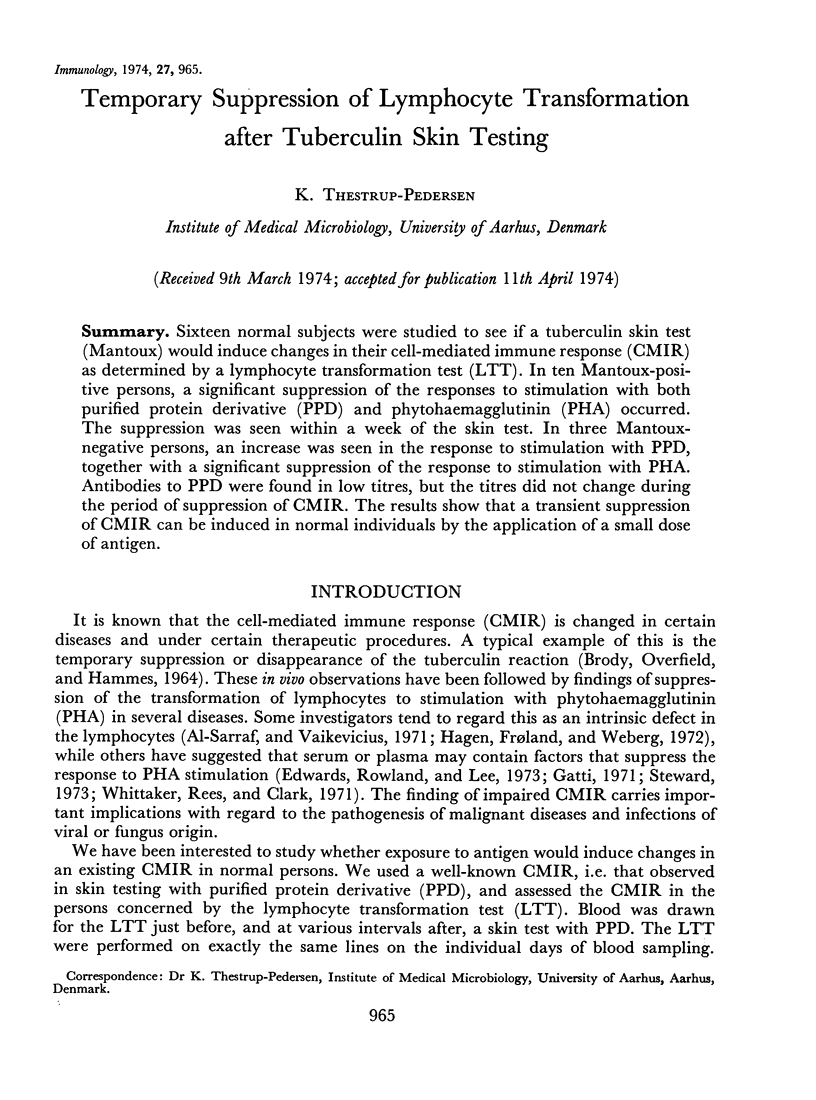

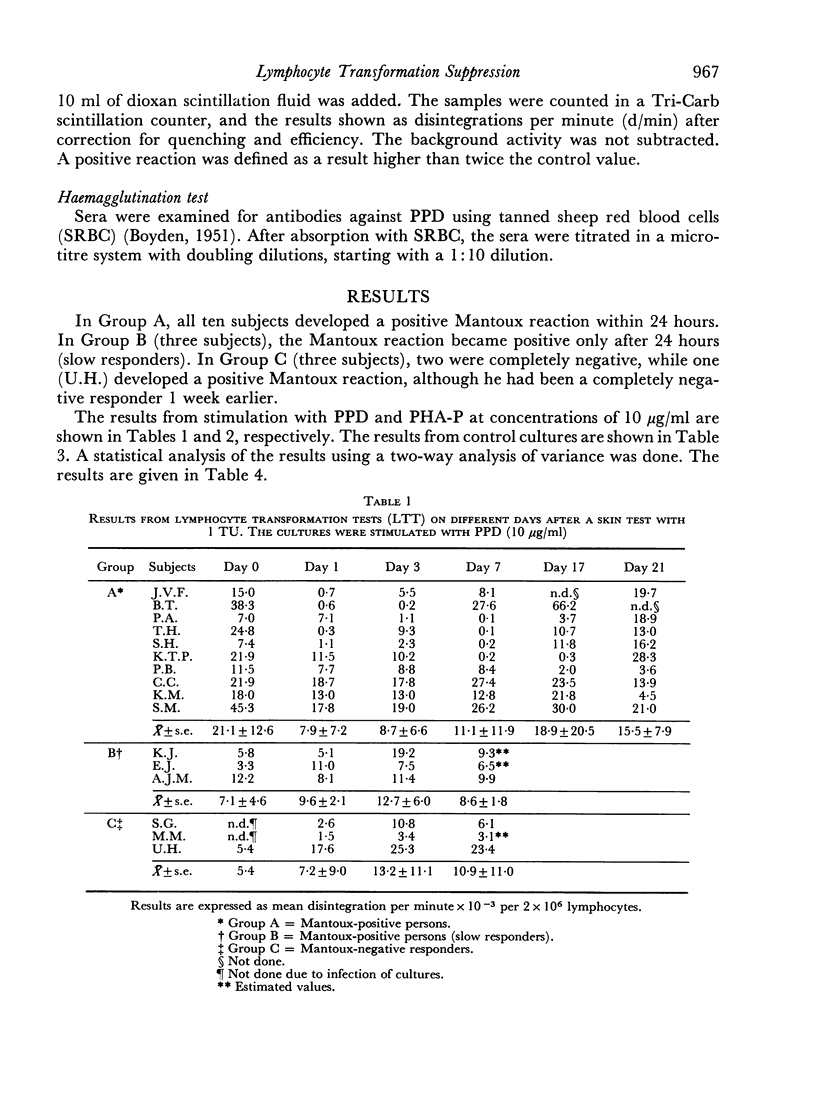
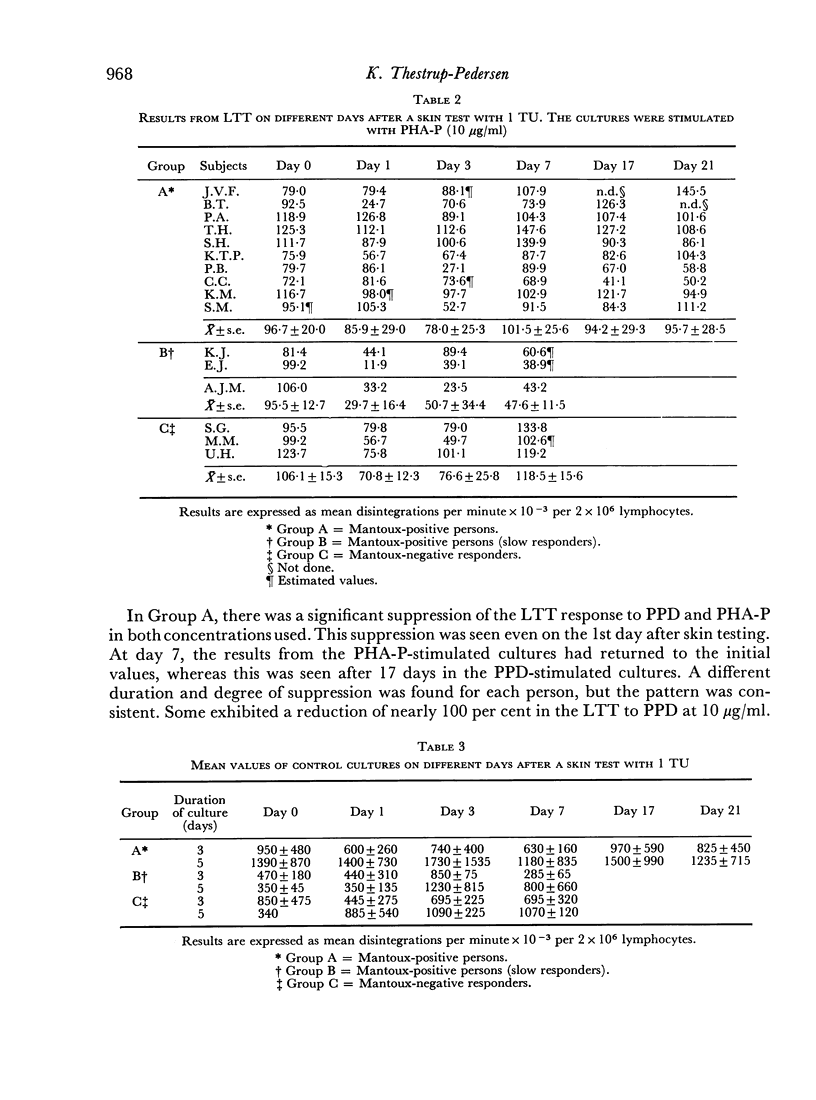
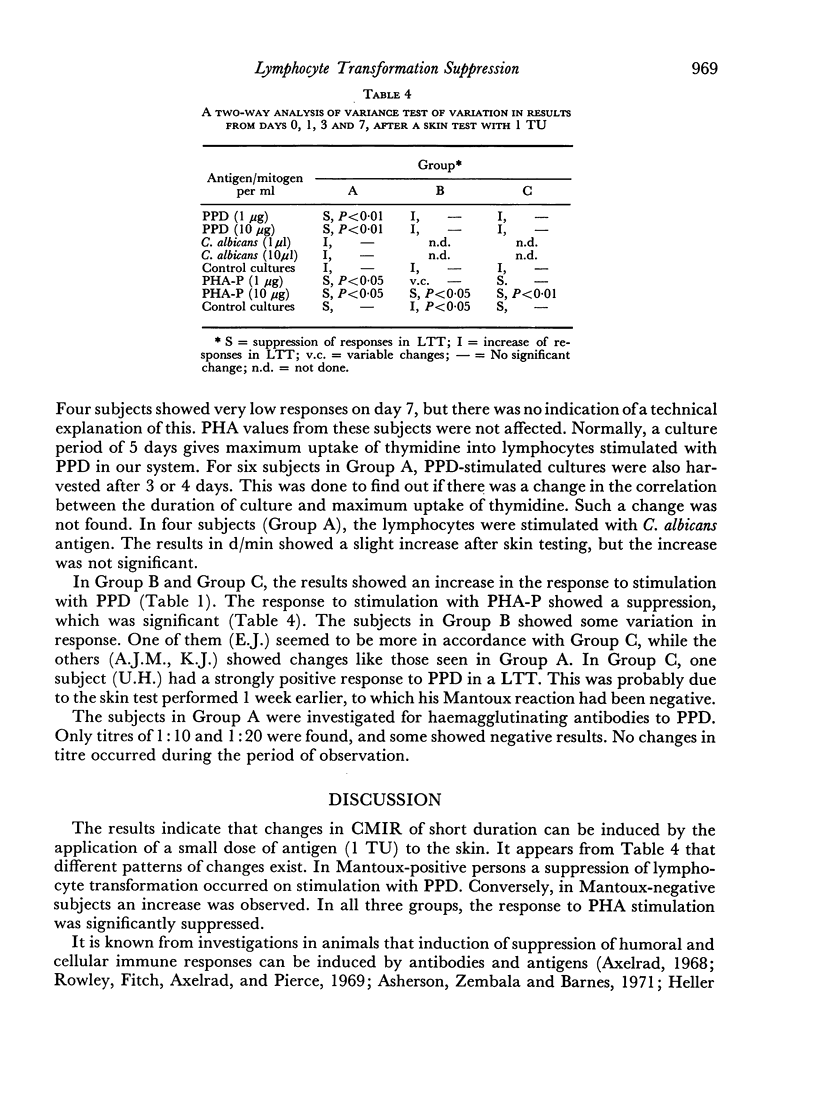
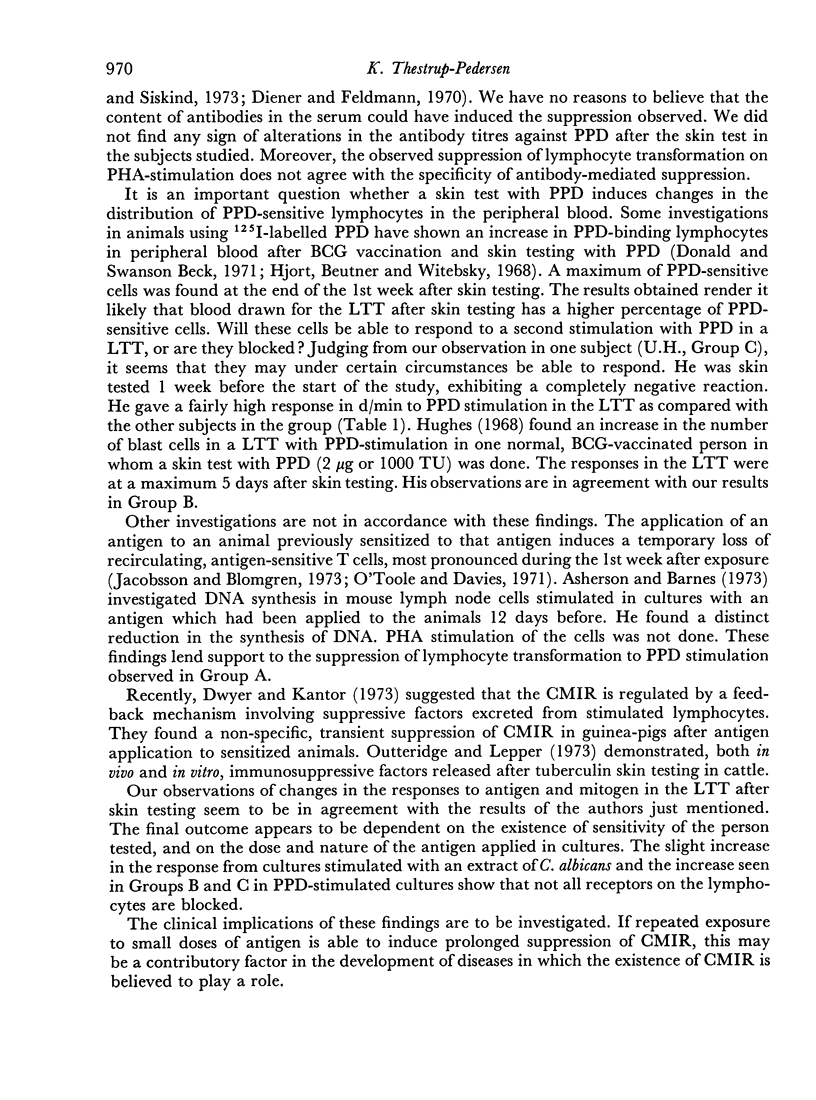

Selected References
These references are in PubMed. This may not be the complete list of references from this article.
- Asherson G. L., Barnes R. M. Classification of immunological unresponsiveness and tolerance. Proc R Soc Med. 1973 May;66(5):468–471. [PMC free article] [PubMed] [Google Scholar]
- Asherson G. L., Zembala M., Barnes R. M. The mechanism of immunological unresponsiveness to picryl chloride and the possible role of antibody mediated depression. Clin Exp Immunol. 1971 Jul;9(1):111–121. [PMC free article] [PubMed] [Google Scholar]
- Axelrad M. A. Suppression of delayed hypersensitivity by antigen and antibody. Is a common precursor cell responsible for both delayed hypersensitivity and antibody formation? Immunology. 1968 Aug;15(2):159–171. [PMC free article] [PubMed] [Google Scholar]
- BOYDEN S. V. The adsorption of proteins on erythrocytes treated with tannic acid and subsequent hemagglutination by antiprotein sera. J Exp Med. 1951 Feb;93(2):107–120. doi: 10.1084/jem.93.2.107. [DOI] [PMC free article] [PubMed] [Google Scholar]
- BRODY J. A., OVERFIELD T., HAMMES L. M. DEPRESSION OF THE TUBERCULIN REACTION BY VIRAL VACCINES. N Engl J Med. 1964 Dec 17;271:1294–1296. doi: 10.1056/NEJM196412172712505. [DOI] [PubMed] [Google Scholar]
- Diener E., Feldmann M. Antibody-mediated suppression of the immune response in vitro. II. A new approach to the phenomenon of immunological tolerance. J Exp Med. 1970 Jul 1;132(1):31–43. doi: 10.1084/jem.132.1.31. [DOI] [PMC free article] [PubMed] [Google Scholar]
- Donald D., Beck J. S. Antigen-binding small lymphocytes in delayed hypersensitivity to tuberculin. Nature. 1971 May 21;231(5299):183–184. doi: 10.1038/231183a0. [DOI] [PubMed] [Google Scholar]
- Dwyer J. M., Kantor F. S. Regulation of delayed hypersensitivity. Failure to transfer delayed hypersensitivity to desensitized guinea pigs. J Exp Med. 1973 Jan 1;137(1):32–41. doi: 10.1084/jem.137.1.32. [DOI] [PMC free article] [PubMed] [Google Scholar]
- Edwards A. J., Rowland G. F., Lee M. R. Reduction of lymphocyte transformation by a factor produced by gastrointestinal cancer. Lancet. 1973 Mar 31;1(7805):687–689. doi: 10.1016/s0140-6736(73)91477-3. [DOI] [PubMed] [Google Scholar]
- Gatti R. A. Serum inhibitors of lymphocyte responses. Lancet. 1971 Jun 26;1(7713):1351–1352. doi: 10.1016/s0140-6736(71)91906-4. [DOI] [PubMed] [Google Scholar]
- Hagen C., Froland A., Weberg E. Lymphocyte transformation in cancer patients. Lancet. 1972 Jun 17;1(7764):1340–1340. doi: 10.1016/s0140-6736(72)91069-0. [DOI] [PubMed] [Google Scholar]
- Hartzman R. J., Bach M. L., Bach F. H., Thurman G. B., Sell K. W. Precipitation of radioactively labeled samples: a semi-automatic multiple-sample processor. Cell Immunol. 1972 Jun;4(2):182–186. doi: 10.1016/0008-8749(72)90018-4. [DOI] [PubMed] [Google Scholar]
- Heller K. S., Siskind G. W. Effect of tolerance and of antibody mediated immune suppression on the avidity of the cellular and humoral immune response. Cell Immunol. 1973 Jan;6(1):59–65. doi: 10.1016/0008-8749(73)90006-3. [DOI] [PubMed] [Google Scholar]
- Hjort T., Beutner E. H., Witebsky E. Uptake of labelled antigens by lymphocytes of rabbits with delayed hypersensitivity reactions. Int Arch Allergy Appl Immunol. 1968;33(4):337–352. doi: 10.1159/000230051. [DOI] [PubMed] [Google Scholar]
- Hughes N. R. Tuberculin sensitive lymphocytes in human peripheral blood following Mantoux test. Aust J Exp Biol Med Sci. 1968 Oct;46(5):619–629. doi: 10.1038/icb.1968.168. [DOI] [PubMed] [Google Scholar]
- Jacobsson H., Blomgren H. Evidence for a loss of recirculating capacity of T-cells after antigenic stimulation. Clin Exp Immunol. 1973 Mar;13(3):439–453. [PMC free article] [PubMed] [Google Scholar]
- O'Toole C. M., Davies A. J. Pre-emption in immunity. Nature. 1971 Mar 19;230(5290):187–189. doi: 10.1038/230187a0. [DOI] [PubMed] [Google Scholar]
- Outteridge P. M., Lepper A. W. Immunosuppressive factors released by transforming lymphocytes in the delayed hypersensitivity skin response to tuberculin. Immunology. 1973 Dec;25(6):981–994. [PMC free article] [PubMed] [Google Scholar]
- Rowley D. A., Fitch F. W., Axelrad M. A., Pierce C. W. The immune response suppressed by specific antibody. Immunology. 1969 Apr;16(4):549–559. [PMC free article] [PubMed] [Google Scholar]
- Steward A. M. Tuberculin reaction in cancer patients, "Mantoux release," and lymphosuppressive-stimulatory factors. J Natl Cancer Inst. 1973 Mar;50(3):625–632. doi: 10.1093/jnci/50.3.625. [DOI] [PubMed] [Google Scholar]
- Whittaker M. G., Rees K., Clark C. G. Reduced lymphocyte transformation in breast cancer. Lancet. 1971 May 1;1(7705):892–893. doi: 10.1016/s0140-6736(71)92448-2. [DOI] [PubMed] [Google Scholar]
- al-Sarraf M., Vaitkevicius V. K. Effect of homologous plasma on lymphocyte transformation in cancer patients and controls. Lancet. 1971 Aug 7;2(7719):314–315. doi: 10.1016/s0140-6736(71)91357-2. [DOI] [PubMed] [Google Scholar]


